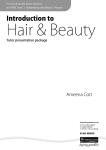Download WRH06 User Guide
Transcript
WRH06 User Guide Doing it Right Industry requirements for implementing the Hairdressing Training Package (WRH06) Hairdressing Training Package Training people well in the hairdressing industry Foreword The hairdressing industry needs highly skilled workers. This User Guide Doing it Right has been developed by Service Skills Australia and sets out strongly-held industry views and expectations regarding training and assessment requirements in the hairdressing industry. It should be used in conjunction with the endorsed WRH06 Hairdressing Training Package. It offers trainers and assessors easy access to a useful resource with information and practical strategies that will assist them in ensuring good practice in skills and knowledge development. It also sets out industry expectations that will inform policy makers and auditors. Industry too, has its part to play in ensuring quality outcomes and effective skills development—by facilitating quality work placement, playing a pro active role in advising training deliverers and developing staff. The key message from industry is: This is what we really need—and here are some tools—how can we all work together to achieve it? Ian Blandthorn Chair, WRAPS Industry Advisory Committee Service Skills Australia updated November 2009 Contents Industry requirements . . . . . . . . . . . . . . . . . . . . . . . . . . . . . . . . . . . . . . . . . . . . . . . . . . . . . . . . . . 1 Training driven by industry demand . . . . . . . . . . . . . . . . . . . . . . . . . . . . . . . . . . . . . . . . . . . . . 2 Priority areas and skills shortages . . . . . . . . . . . . . . . . . . . . . . . . . . . . . . . . . . . . . . . . . . . . . . . . . . . . . . . . . . 2 Starting out in the hairdressing industry . . . . . . . . . . . . . . . . . . . . . . . . . . . . . . . . . . . . . . . . . . . . . . . . . . . 2 Work ready graduates . . . . . . . . . . . . . . . . . . . . . . . . . . . . . . . . . . . . . . . . . . . . . . . . . . . . . . . . . . 3 Employing qualified hairdressers . . . . . . . . . . . . . . . . . . . . . . . . . . . . . . . . . . . . . . . . . . . . . . . . . . . . . . . . . . 3 Delivery duration . . . . . . . . . . . . . . . . . . . . . . . . . . . . . . . . . . . . . . . . . . . . . . . . . . . . . . . . . . . . . . . . . . . . . . . . . 4 Funding models are not delivery models . . . . . . . . . . . . . . . . . . . . . . . . . . . . . . . . . . . . . . . . . . . . . . . . . . 4 Minimum learning and assessment hours . . . . . . . . . . . . . . . . . . . . . . . . . . . . . . . . . . . . . . . . . . . . . . . . . 5 Registered training organisations with realistic programs and business models . . . . 6 Being realistic about what can be achieved and delivering industry acceptable outcomes . 6 VET in schools . . . . . . . . . . . . . . . . . . . . . . . . . . . . . . . . . . . . . . . . . . . . . . . . . . . . . . . . . . . . . . . . . . . . . . . . . . . . 7 Developing more complex or additional technical or training skills and knowledge . . . . . . . . 7 Developing small business and salon management skills . . . . . . . . . . . . . . . . . . . . . . . . . . . . . . . . . . 8 Integrated and contextualised training and assessment practices . . . . . . . . . . . . . . . . . . 9 Integrated delivery . . . . . . . . . . . . . . . . . . . . . . . . . . . . . . . . . . . . . . . . . . . . . . . . . . . . . . . . . . . . . . . . . . . . . . . . 9 Training and assessing in a hairdressing workplace context . . . . . . . . . . . . . . . . . . . . . . . . . . . . . . . . 9 Salon delivery . . . . . . . . . . . . . . . . . . . . . . . . . . . . . . . . . . . . . . . . . . . . . . . . . . . . . . . . . . . . . . . . . . . . . . . . . . . . 12 AQTF 2007 Essential Standards for Registration . . . . . . . . . . . . . . . . . . . . . . . . . . . . . . . . . . . . . . . . . . . 16 Additional hairdressing industry requirements for trainers and assessors . . . . . . . . . . . . . . . . . . 16 Additional advice for WRH06 Hairdressing Training Package users . . . . . . . . . . . . . . . . 17 Minimum learning and assessment hours . . . . . . . . . . . . . . . . . . . . . . . . . . . . . . . . . . . . . . . . . . . . . . . . 17 Providing language literacy and numeracy support . . . . . . . . . . . . . . . . . . . . . . . . . . . . . . . . . . . . . . 22 Notes . . . . . . . . . . . . . . . . . . . . . . . . . . . . . . . . . . . . . . . . . . . . . . . . . . . . . . . . . . . . . . . . . . . . . . . . . 23 this page is intentionally blank Industry requirements This User Guide is a series of ‘good practice’ fact sheets. They identify and explain key hairdressing industry objectives in skills and knowledge development. These fact sheets also contain suggested tools and ideas to assist employers, registered training organisations, assessors and trainers work with the training package and develop graduates who are ready for the industry. The following topics are covered: • Training driven by industry demand • Work ready graduates • Registered training organisations (RTOs) with realistic programs and business models • Integrated and contextualised training and assessment practice • Qualified trainers and assessors • Additional advice for WRH06 Hairdressing Training Package users • Over time, the suite of tools and resources available on the Service Skills Australia website (www.serviceskills.com.au) will be expanded to include many free good practice sample tools and ideas that will enable RTOs to work with industry to develop quality training outcomes. 1 Industry wants... Training driven by industry demand Priority areas and skills shortages The WRH06 Certificate III in Hairdressing is regarded by the industry as the core qualification. Quality graduates of the Certificate III in Hairdressing are in great demand as they are the practising hairdressers in salon work teams. Many employers also look for more complex or specialised technical skill sets and these may have been gained via several modes, including formal training programs, manufacturers’ workshops, participation in key industry events and in-salon training. As an area of small business, the hairdressing industry also needs managers and employers with strong business skills. Registered training organisations are encouraged to offer small business and salon management skills training via units in the Certificate IV in Hairdressing and the Diploma of Hairdressing Salon Management. Starting out in the hairdressing industry Hairdressing industry employers are keen to engage with new industry entrants who have the life skills and attitudes that are suited to a creative customer service industry and then train them via an apprenticeship at Certificate III level. Employing new apprentices Ideal applicants for apprenticeship are described as: • ‘passionate’ about being a hairdresser • having an interest in fashion • having done some research either on the salon or the industry • preferably having some experience in a customer service environment (perhaps in part time employment as a hairdressing salon assistant or in retail) • able to demonstrate team skills through other employment, volunteering or sport • outgoing • having a good command of English and strong communication skills • fit enough to cope with a job that is performed over long hours on their feet and • displaying a positive work ethic. The hairdressing industry wants RTOs to also consider these skills and attributes when selecting students for hairdressing institutional pathway programs. 2 Industry wants... Work ready graduates The Certificate III in Hairdressing has been designed as the standard entry level qualification for the hairdressing industry. Likely functions in the hairdressing industry for those who achieve this qualification involve employment as a hairdresser working as part of a team in a salon, performing processes that require a range of well developed skills where discretion and judgement is required with responsibility for own outputs, and responsibility for the supervision of others, including apprentices. Functions at this level include applying skills and knowledge to sell products and services, ensuring a safe working environment and performing a full range of client services, including client consultation and advice, hair and scalp treatments, haircutting, hair design, colour and lightening, and chemical reformation services on male and/or female clients. Employing qualified hairdressers All applicants for positions as qualified hairdressers must, as a minimum, be able to demonstrate: • Successful completion of the Certificate III in Hairdressing. This means practical workplace experience in applying all of the core competencies in the Certificate III in Hairdressing and also those elective competencies that are preferred by the employing salon. Example: • A salon that provides haircutting services to male and female clients will be looking to select candidates who are competent in the full range of technical skills and knowledge described in the elective unit WRHHC306A Combine haircut structures on women and also the elective unit WRHHC307A Combine haircut structures for traditional and classic designs on men. • The ability to effectively integrate and independently perform a full range of hairdressing services on a variety of clients in an operating hairdressing salon situation within industry-accepted timeframes. This involves: -- Consistently managing multiple services within the salon range. -- Operating as an effective team‑member, and dealing effectively with the contingencies that arise when performing multiple services in a salon team that includes salon assistants, apprentices, senior hairdressers, receptionists, supervisors and managers. -- Knowledge and consistent application of relevant legislation and workplace practices, particularly in regard to workplace safety and hygiene and waste minimisation. • That they are fit enough to cope with a job that is performed over long hours on their feet. • That they have a strong work ethic. • That they are keen to continue to develop their technical skills and knowledge. Hairdressing employers are always happy to consider hairdressing job applicants who have trained via apprenticeship. Increasingly employers must consider hairdressing graduate job applicants, who have achieved WRH30106 Certificate III in Hairdressing via institutional pathways. Graduates who have not undertaken an apprenticeship but have achieved this qualification via an institutional pathway must also meet all of the industry requirements listed above. 3 Delivery duration This industry uses apprenticeship training as its benchmark and strongly endorses the formative development of skills; that is building the full range of required hairdressing skills and knowledge over time. It is reasonable to assume that institutional programs should provide sufficient time to allow the full development of hairdressing and employability skills. The hairdressing industry has frequently expressed the view that the ‘short’ delivery duration of a number of institutionally delivered programs is a key factor in their inability to produce salon ready graduates. Nominal hours allocated in purchasing, implementation or mapping guides developed by state training authorities may be a device for funding the off-the-job component of hairdressing apprenticeship training and therefore should not be regarded as sufficient on their own in order for a learner to achieve competency. Funding models are not delivery models Nominal hours of training are allocated to individual units of competency in purchasing, mapping or implementation guides, developed by some state training authorities. Nominal hours are not always the same across states and territories. Some states use nominal hours to fund training. In the case of the holistic units in hairdressing the allocation of nominal hours varies dramatically across states/territories. While acknowledging the implications of nominal hours for registered training organisations, the focus for employers is wholly on the outcomes of training. Industry takes the view that competency cannot be achieved without a holistic work integrated approach to learning and assessment, along with sufficient practice and workplace application—well outside the limits of nominal hours. For example, attempting to achieve WRH06 Certificate III in Hairdressing outcomes for institutional learners without effective work integration strategies and the proper allocation of time (800hrs minimum) to the work integration unit WRHWP302A Operate effectively as a hairdresser in a salon work teams is clearly not achievable. The hairdressing industry will actively support RTOs who develop innovative ways of addressing resource challenges in order to achieve quality outcomes. It also strongly believes that an RTO should only offer programs where it can successfully meet those challenges—both for the sake of individual students and for the industry more broadly. Example: The following comparison between an apprenticeship pathway and an institutional pathway is based on current Victorian arrangements. Apprenticeship duration, the definition and treatment of nominal hours, and funding arrangements for the delivery of the hairdressing training package qualifications continue to vary across states and territories. Nevertheless, this example illustrates the need for more flexible and work integrated approaches to the institutional delivery of qualifications across Australia. 4 Certificate III in Hairdressing apprenticeship Duration Victorian Hairdressing Apprenticeship Duration: 3 years or 36 months Certificate III in Hairdressing institutional pathway Duration Most institutional courses are intensive and over approximately 1 year. Total apprenticeship hours (based on a 38 hour week) over 3 years less annual leave and public holidays = 5385 Delivery hours appear to range from Off the job training time Apprenticeship off the job training = 705-808 Off the job training time Varies between 650 and 1600 according to quality of training provision. Integrating learning and workplace experience Integrating learning and workplace experience If we deduct the off the job training maximum of 808 nominal hours, as per the Victorian Purchasing Guide, this leaves 4577 hours spent on the job over the course of an apprenticeship. In order to achieve equivalent quality of outcomes, an institutional learner requires a significant number of hours beyond those expressed in the Purchasing Guide which has been developed for the purchase of Apprenticeship training places. During these hours spent on the job, skills learned in off-the-job training are progressively applied under supervision, in an integrated manner, until the apprentice is performing a full range of complex salon services and team tasks during the final months of the apprenticeship. The unit WRHWP302A Operate effectively as a hairdresser in a salon work team is a compulsory unit for institutional learners undertaking the Certificate III in Hairdressing. The quality structured learning time that is integrated into this 4577 hours is not easily quantifiable and would vary across businesses. At a minimum it would be reasonable to assume 25% or 1144 hours. A minimum of 800 hours of learning via supervised work integrated experience would ensure the potential for institutional learners to achieve equitable outcomes. 650-1600 across different training providers Minimum learning and assessment hours Minimum learning and assessment hours as defined by the hairdressing industry are not related to course funding. They are an industry minimum based on a composite of structured (or formal) learning and assessment, and workplace integration of skills and knowledge. This composite figure includes nominal hours allocated to units of competency in state or territory implementation, purchasing or mapping guides and the additional recognition of the time taken to integrate hairdressing skills and knowledge in a workplace context. For institutional learners undertaking Certificates II and III, this means that RTOs should plan, document and implement the integration of learning and assessment of the relevant workplace unit with relevant corequisite units. Industry recommended minimum learning and assessment hours allocated to workplace units should be undertaken in industry, a simulated work environment, or a combination of both. For trainees and apprentices, learning and assessment should also be integrated with structured workplace practice; either on the job or in a simulated work environment. Hairdressing industry expectations regarding minimum learning and assessment hours for all units in the WRH06 Hairdressing Training Package are set out in the section headed Additional advice for WRH06 Hairdressing Training Package Users at the back of this guide. 5 Industry wants... Registered training organisations with realistic programs and business models Being realistic about what can be achieved and delivering industry acceptable outcomes Achieving quality outcomes from any training depends on everyone making an honest and realistic assessment of what can be achieved in a given set of circumstances. • Some employers may not be able to provide the required range of experience for an individual undertaking Certificate III in Hairdressing so arrangements need to be put in place to address this. • An RTO may not have the required resources (or external access to required resources) to support delivery of particular qualifications. Resources might be a fully-equipped simulated salon, an adequate supply of teachers with current and relevant experience or access to hairdressing workplaces. Employing Certificate II graduates as apprentices There are very few jobs in the industry for Certificate II graduates. Some employers will consider employing Certificate II graduates as apprentices, if they judge that the individual applicant meets the above profile and is therefore suited to the hairdressing industry. Given that these graduates are entitled to recognition of the competencies they have achieved via the Certificate II, and therefore a shorter apprenticeship period, employers also expect these applicants to have: • excellent salon team skills • a high level of skills and knowledge application in basin skills • how to do a basic hair and scalp analysis and select shampoo and treatments • excellent head massage skills • basic blow drying skills • a good basic understanding of how to safely handle tools such as blow dryers, tongs, razors, scissors when getting equipment ready or cleaning up after a senior stylist • the ability to remove all types of hair colouring • good oral communication skills including the ability to make and sustain conversation with customers and colleagues and respond to verbal instructions • able to read and comprehend work related documents including manufacturer instructions and write short, work related texts • able to deal easily with straightforward mathematical calculations either manually and/or using a calculator and • a working understanding of occupational health and safety requirements in a hairdressing salon environment. These industry requirements reflect successful completion of all of the required competencies in the WRH20106 Certificate II in Hairdressing. Graduates trained via a traineeship or an institutional pathway must equally demonstrate excellent salon team skills. Trainees gain these skills via their on-the-job experience. For institutional learners this is made possible through the proper application and successful completion of the work integration unit WRHWP201A Assist colleagues providing multiple salon services as a team member. 6 Hairdressing employers say that most Certificate II in Hairdressing graduates from institutional programs do not have all the skills and knowledge described in the qualification. These are widely described by employers as the minimum standard for an apprentice undertaking the Certificate III in Hairdressing, after 6 months on the job. Tools Go to www.serviceskills.com.au to download sample student selection tools and checklists that reflect industry requirements. VET in schools Supporting school students in achieving vocational skills In some industries, Certificate I and Certificate II qualifications are regarded as ‘pathway’ qualifications or as preparatory study. All stakeholders accept that those qualifications do not reflect particular job outcomes. In the hairdressing industry, a Certificate II qualification is a pathway that offers significant time credit taken off the benchmark apprenticeship. For this reason, employers expect students with this qualification to be ready to work and equally as competent as an apprentice who is 6 months into training. In some states and territories the Certificate II in Hairdressing may be completed via a traineeship while in others it is offered as an institutional program with work experience. The fact that the qualification has been gained while still at school should in no way affect the equality of qualification outcomes and devalue what has been achieved. The hairdressing industry strongly encourages any school considering the delivery of the Certificate II in Hairdressing to carefully assess its planning and resource capacity to provide quality work integrated learning experiences that will achieve the outcomes industry needs. Developing more complex or additional technical or training skills and knowledge The hairdressing industry needs hairdressers with innovative design, technical and training skills. This learning is actively pursued by practitioners via many modes, including manufacturers’ workshops and training programs, participation in key industry events, in-salon training or formal training programs. Such industry skills and knowledge may be recognised or learned via units that are packaged as part of the WRH40106 Certificate IV in Hairdressing. Innovative RTOs pro-actively seek to work flexibly with employers, manufacturers and individuals; in order to recognise existing skills and knowledge developed via any of these modes, and offer training where there are skills gaps. This recognition validates the complex skills and knowledge already held by highly skilled leading hairdressers and encourages young hairdressers to seek the further training and development they require for a long term career path in our industry. Tools Go to www.serviceskills.com.au to download further information and tools regarding recognition of current competency for skilled hairdressers. 7 Developing small business and salon management skills The hairdressing industry needs managers and employers with strong business skills. Small business and salon management skills are available via units in the Certificate IV in Hairdressing and the WRH50106 Diploma of Hairdressing Salon Management. These qualifications open up career pathways to successful management roles and business ownership for hairdressers. RTOs should also inform their students that higher education pathways do exist from the Diploma of Hairdressing Salon Management qualification, and offer significant credit towards undergraduate degrees in business at some universities. Tools Go to www.serviceskills.com.au to download further information on negotiated pathways between the Diploma of Hairdressing and undergraduate business degrees. 8 Industry wants... Integrated and contextualised training and assessment practices When developing delivery and assessment strategies RTOs must refer to the Assessment Guidelines of the WRH06 Hairdressing Training Package for guidance on an appropriate delivery and assessment environment. Integrated delivery The hairdressing industry supports the integrated delivery and assessment of units of competency because it reflects real work practice. An integrated delivery approach brings together a number of units of competency that reflect actual workplace requirements. For example, an employee working in a hairdressing salon would complete a number of interrelated customer service, administration and technical tasks together, not simply one individual task at a time or in a set sequence. Integrating the development of skills and knowledge with their application in the workplace requires a structured approach that encourages students to participate in and actively contribute to their own learning. An integrated assessment activity would be designed to collect evidence for a number of units together, rather than designing one assessment activity for each individual unit, or for individual elements and performance criteria. Tools Go to www.serviceskills.com.au to download useful additional further information and templates on the integrated delivery and assessment of the Certificate III in Hairdressing. Training and assessing in a hairdressing workplace context It is the strongly held industry view that graduates from some institutional pathway programs are unable to perform to industry standards. In response to this concern, the unit of competency WRHWP302A Operate effectively as a hairdresser in a salon work team has been developed as a mandatory elective for those students undertaking WRH30101 Certificate III in Hairdressing via an institutional pathway. This unit does not apply to those students undertaking an apprenticeship pathway. The unit reinforces the formative development of hairdressing skills and the need to deliver and assess, in an institutional pathway, those skills which are routinely gained over time through an apprenticeship mode in order to ensure equivalence of outcomes for all students. Industry has determined that due to hairdressing services being based upon close, personal interaction between client and operator, learning and assessment in a real workplace context is most appropriate whenever possible. Competency should therefore be demonstrated in the workplace and/or in a simulated workplace environment, as detailed in each unit of competency. 9 For the purposes of assessment, a workplace or simulated hairdressing salon is defined as: One in which all of the skills of hairdressing are performed in a commercially operating salon with respect to the provision of paid services to the public, while the salon is open for business. A simulated work environment may be required for the following reasons: • the learner may not have access to a workplace • the workplace may not use the relevant skill, equipment or process • conducting assessments may be disruptive or interfere with work requirements, e.g. there may be ethical, privacy or confidentiality issues to consider or • it may not be appropriate to apply the skills in the workplace due to potential risks to such things as health and safety, or to equipment being damaged. In order to be valid and reliable, the simulation must closely resemble what occurs in a real work environment. The simulated work environment should involve a range of activities that reflect real work experience. It is critical that when a simulated work environment is being set up, the assessor or trainer is thoroughly familiar with the competency standard, as well as experienced in the current circumstances and environment of the workplace. In deciding whether a training simulation or an assessment environment has been adequately set up, the following criteria must be applied: • provide access to the full range of up-to-date equipment and software that would generally be available in a modern working hairdressing salon. • Stock a comprehensive salon product range that will support the development and demonstration of the full range of skills and knowledge described in WRH06 Hairdressing Training Package units of competency. • Operate a fully functional reception area with a client booking and records system where candidates are able to make new and repeat appointments with clients through telephone or face-to-face contact, establish and update client records, maintain a retail display area and promote and sell retail home haircare products that are available for purchase. • Provide sufficient client traffic that accurately reflects the complexity of the role and allows learners/ candidates to deal with multiple salon tasks simultaneously. • Require that learners/candidates provide services within timeframes that reflect accepted industry service times. • Involve learners/candidates in prioritising competing tasks. • Allow learners/candidates to deal with customers, including difficult ones. • Require learners/candidates to work with others in a team, which would typically include salon assistants, apprentices, senior hairdressers, receptionists, supervisors and managers. • Provide all the skills of hairdressing to the public as defined in WRH06 Hairdressing Training Package. Further information regarding a simulated workplace may be found in the WRHO6 Hairdressing Training Package Assessment Guidelines. Tools To download an online version of this checklist, go to www.serviceskills.com.au 10 WRH06 Hairdressing Training Package checklist - simulated salon In deciding whether a simulated salon has been adequately set up, the following questions should be considered. A tick () should appear beside each question in order to achieve compliance with the requirements in the Assessment Guidelines. Yes No Are there opportunities to access the full range of up-to-date equipment and software that would generally be available in a modern working hairdressing salon? Does the simulated salon stock a comprehensive salon product range that will support the development and demonstration of the full range of skills and knowledge described in all WRH06 Hairdressing Training Package units of competency? Does the simulation provide learners with experience operating a fully functional reception area with a client booking and records system where they are able to: • make new and repeat appointments with clients through telephone or face-to-face contact • establish and update client records • maintain a retail display area • promote and sell retail home hair-care products that are available for purchase? Does the simulated salon provide sufficient client traffic that accurately reflects the complexity of the role and allows learners/ candidates to deal with multiple salon tasks simultaneously? Does the simulation require that learners/candidates provide services within timeframes that reflect accepted industry service times? Does the simulation involve learners/candidates in prioritising competing tasks? Does the simulation allow learners/candidates to deal with customers, including difficult ones? Has the simulation been planned to require learners/candidates to work with others in a team, which would typically include salon assistants, apprentices, senior hairdressers, receptionists, supervisors and managers? Has the simulation allowed the learner to provide all the skills of hairdressing to the public as defined in WRH06 Hairdressing Training Package? 11 Salon delivery Where an RTO does not have access to a simulated salon which meets the requirements specified in the training package, and conducts all or part of its delivery in an industry salon, the RTO must also ensure that all of the above criteria are met in order to satisfy the assessment requirements of the training package. RTOs should be aware of state/territory legislative requirements and their own responsibilities when placing learners in industry salons for the purpose of training. RTOs should provide salon owners/managers with support material to assist in structured, demonstrable training for the learner. Salons should be aware of the performance already achieved by the learner and their level of proficiency. Salons should also be aware of the RTO expectations regarding the type of in-salon tasks a learner would be undertaking as part of their training. It is recognised that learners placed in salons that are commercially operating as part of their training, benefit most when: • the skills to be learned are clearly specified and agreed to in writing and • a workplace supervisor is assigned to guide and oversee learners’ progress. For each placement, RTOs: • Should provide salons with an indication of the level of expertise of the learner and the specific performance outcomes that are expected from the salon training. • Must also provide learners with a clear understanding of the salon training they will receive and the expectations of the salon and the RTO. • Should be able to provide evidence of sample salon delivery tool which maps the formative development of skills over a number of placements integrating on and off job delivery; and the formative and summative assessment of all units required to achieve this qualification as expressed in the WRH06 Hairdressing Training Package. • Review the plan regularly in conjunction with the placement salon and the learner to determine the learner’s progress and to identify any issues which may impact on successful delivery of the qualification. Tools The following template for salon delivery provides an example of how RTOs can provide salons with an indication of the level of expertise of the learner and the specific performance outcomes that are expected from the salon training. It can also provide learners with a clear understanding of the salon training they will receive and the expectations of the salon and the RTO. Go to www.serviceskills.com.au to download online versions of this template. 12 WRH06 Hairdressing Training Package salon training delivery Student Name: Contact: Qualification: WRH30106 Certificate III in Hairdressing RTO: Contact: Salon: Contact: Training undertaken: This can be recorded using both units of competency by code and title and specific outcomes, skills and knowledge achieved by the learner. Salons may find it more relevant to see the specific achievements of the learner while RTOs and learners may be more familiar with the units of competency. This section should also indicate the level of supervision the RTO requires the learner to have during their training. This level of supervision may vary for each trainee and each specific skill area according to the level of proficiency of each learner. Training to be undertaken: This should indicate specific outcomes and skills that the learner is expected to practice in the salon. It should be revised at each review period to ensure that skills are developed in a structured way and that learners are given the opportunity to cover all required aspects of their qualification over time. The information can be presented as a checklist for salons to mark off as each skill is covered. Start date: Review date: End date: Learner: RTO: Salon: The following sample salon delivery tool (templates A & B) details the training undertaken by a learner who is in the initial stage of their qualification and is completing their first salon delivery component. While some proficiency has been established in the training environment the learner now needs to integrate their performance into the salon work environment. Tools Go to www.serviceskills.com.au to download online versions of these templates. 13 Template A WRH06 Hairdressing Training Package salon training delivery Student Name: Contact: Qualification: WRH30106 Certificate III in Hairdressing 14 RTO: Contact: Salon: Contact: Training undertaken: Skills achieved: Supervision WRRLP1B Apply safe working practices Knows OHS responsibilities, recognises potential unsafe salon work practices High WRHCS205A Follow personal health and safety routines at work Correctly applies protective equipment, OHS regulations, health and hygiene requirements Handles hairdressing equipment safely and applies electrical safety Medium WRHCS202A Maintain tools and equipment Recognises and reports unsafe equipment, cleans and disinfects hairdressing tools and equipment, stores linen and tools and equipment safely Medium WRHCS201A Prepare clients for salon services Consults clients and other operators to verify service, gowns and wraps, recognises unusual scalp conditions, applies shampoo and treatment products according to instructions Medium WRHCL201A Apply temporary hair colour and remove residual products Selects and applies and removes colour products according to instructions from senior operator, applies treatment products High WRHWP302A Operate effectively as a hairdresser in a salon work team Minimal exposure to integration of skills High Template B Training to be undertaken: Performance demonstrated WRRLP1B Apply safe working practices Applies OHS responsibilities, recognises and reports or addresses potential unsafe salon work practices according to salon policy WRHCS205A Follow personal health and safety routines at work Integrates the use of protective equipment, application of OHS regulations, health and hygiene practices and the use of hairdressing equipment into salon work tasks without direction WRHCS202A Maintain tools and equipment Integrates the maintenance, cleaning and storage of hairdressing tools and equipment into salon work tasks with minimal direction WRHCS201A Prepare clients for salon services Performs all client preparation tasks and responds to other operators with some need for direction. WRHCL201A Apply temporary hair colour and remove residual products Selects and applies and removes colour products according to instructions from senior operator, applies treatment products WRHWP302A Operate effectively as a hairdresser in a salon work team Recognises opportunities to assist other operators and undertakes maintenance and cleaning tasks during quiet periods Comments: satisfactory progress overall. More attention needs to be paid to the demands of other operators and speed of operation needs top be improved. Start date: Review date: End date: Learner: RTO: Salon: Remember: The plan should be reviewed regularly by the RTO in conjunction with the salon and the learner to determine the learner’s progress and to identify any issues which may impact on successful delivery of the qualification. 15 Industry wants... Qualified trainers and assessors AQTF 2007 Essential Standards for Registration The Australian Quality Training Framework 2007 Essential Standards for Registration specify the requirements to be met by RTOs throughout their period of registration. The National Quality Council is responsible for determining the training and assessment competencies to be held by trainers and assessors in accordance with Element 1.4 of the standards. All trainers and assessors of the WRH06 Hairdressing Training Package must meet the requirements of Standard 1.4 as determined by National Quality Council on 29 March 2007. Tools In order to access the current determination of the National Quality Council relating to the qualifications of trainers and assessors; go to www.training.com.au and follow the links to download the User’s Guide to the Essential Standards for Registration. Additional hairdressing industry requirements for trainers and assessors The following extract from the WRH06 Hairdressing Training Package outlines industry requirements for assessors. Certificates II, III and IV in Hairdressing The assessor is required to: • hold a hairdressing trade qualification as recognised by the state or territory in which they will be assessing, plus have a minimum of two years post-trade experience. Post-trade experience is defined as experience gained following the hairdresser having satisfied all requirements to be recognised as a qualified hairdresser in the relevant state or territory, including meeting any licensing requirements. The post-trade experience will be current and will have been gained in a commercial hairdressing salon. (Currency is defined as equivalent to a minimum of one week of commercial hairdressing salon experience within the past year.) • demonstrate a knowledge and understanding of the current requirements for assessing against the units in WRH06 Hairdressing Training Package. Certificate IV in Trichology The assessor is required to: • hold a Certificate IV in Trichology or the equivalent thereof, and have a minimum of one year of clinical experience. Diploma of Hairdressing Salon Management The assessor is required to: • hold a relevant qualification as recognised by the state or territory in which they will be assessing, plus have a minimum of two years post-qualification experience in hairdressing, beauty or a similar personal services industry. • demonstrate knowledge of the current requirements for assessing against WRH06 Hairdressing Training Package. 16 Industry wants... Additional advice for WRH06 Hairdressing Training Package users Minimum learning and assessment hours Minimum learning and assessment hours as defined by the hairdressing industry are not related to course funding. They are an industry minimum, based on a composite of structured (or formal) learning and assessment plus workplace integration of skills and knowledge. This composite figure includes nominal hours allocated to units of competency in state or territory implementation, purchasing or mapping guides plus the additional recognition of the time taken to integrate hairdressing skills and knowledge in a workplace context. For institutional learners, undertaking Certificates II and III this means that RTOs should plan, document and implement the integration of learning and assessment of the relevant holistic unit with relevant corequisite units. Industry recommended minimum learning and assessment hours allocated to workplace units should be undertaken in industry, a simulated work environment, or a combination of both. For trainees and apprentices, learning and assessment should also be integrated with structured workplace practice either on the job or in a simulated work environment. Hairdressing units The following table sets out the hairdressing units in the WRH06 Hairdressing Training Package and their industry recommended minimum learning and assessment hours. Code Unit title Minimum learning and assessment hours WRHCL201B Apply temporary hair colour and remove residual colour products 25 WRHCL302B Colour and lighten hair 35 WRHCL303B Design and perform full and partial highlighting techniques 25 WRHCL304B Perform colour correction 35 WRHCL305B Perform on scalp full head and re-touch bleach services 30 WRHCL406B Solve complex colour problems 40 WRHCR201B Rinse and neutralise chemically curled or volumised hair 25 WRHCR302B Perform chemical curling and volumising services 50 WRHCR303B Perform chemical straightening and relaxing services 30 WRHCR404B Apply chemical reformation techniques to enhance hair designs 40 WRHCS201B Prepare clients for salon services 20 WRHCS202B Maintain tools and equipment 10 WRHCS203B Hone and strop straight razors 10 WRHCS204B Maintain and organise work areas 10 WRHCS205B Follow personal health and safety routines at work 15 WRHCS206B Perform head, neck and shoulder massage 20 WRHCS207B Develop hairdressing industry knowledge 15 WRHCS308B Plan services for special events 20 WRHHC301B Design haircut structures 20 WRHHC303B Apply graduated haircut structures 30 17 18 Code Unit title Minimum learning and assessment hours WRHHC304B Apply layered haircut structures 30 WRHHC305B Apply over-comb techniques 25 WRHHC306B Combine haircut structures on women 25 WRHHC307B Combine haircut structures for traditional and classic designs on men 20 WRHHC308B Design and maintain beards and moustaches 10 WRHHC309B Perform face and head shaves 25 WRHHC410B Design and perform creative haircuts 40 WRHHD201B Dry hair to shape 35 WRHHD202B Apply single, two and three strand braiding techniques 30 WRHHD303B Design and apply short to medium-length hair design finishes 40 WRHHD304B Design and apply long hair design finishes 30 WRHHD405B Select and apply hair extensions 30 WRHHD406B Work as a session stylist 40 WRHHD407B Apply and maintain wigs and hairpieces 40 WRHHD408B Make wigs and hairpieces 120 WRHHS301B Apply the principles of hairdressing science 25 WRHHS302B Consult with clients and treat hair and scalp conditions 15 WRHHS403B Apply knowledge of hair and scalp problems to trichological consultations 40 WRHHS404B Perform trichological assessments 40 WRHHS405B Apply the principles of nutrition 25 WRHHS406B Develop and apply scalp treatment therapies 30 WRHHS407B Perform hair loss diagnosis 30 WRHHS408B Design and provide nutritional therapies 30 WRHHS409B Design and apply hair loss therapies 30 WRHSM501B Manage hairdressing services and sales delivery 35 WRHSM502B Promote a hairdressing business 40 WRHWP201B Assist colleagues providing multiple salon services as a team member 150 WRHWP302B Operate effectively as a hairdresser in a salon work team 800 Imported units of competency The following table sets out the imported units of competency in WRH06 Hairdressing Training Package and their industry recommended minimum learning and assessment hours. Code Unit title Minimum learning and assessment hours BSB01 Business Services Training Package BSBCUS501A Manage quality customer service 40 BSBEBU501A Investigate and design e-business solutions 50 BSBFRA501B Establish a franchise operation 120 BSBFRA502B Manage a franchise operation 50 BSBMGT516A Facilitate continuous improvement 60 BSBMKG502B Establish and adjust the marketing mix 60 BSBMKG507A Interpret market trends and developments 50 BSBRES401A Analyse and present research information 40 BSBSMB301A Investigate micro business opportunities 30 BSBSBM401A Establish legal and risk management requirements of small business 60 BSBSBM402A Plan small business finances 50 BSBSBM403A Market the small business 50 BSBSBM404A Undertake small business planning 50 BSBSBM405A Monitor and manage small business operations 45 BSBSBM406A Manage small business finances 60 BSBSBM407A Manage a small team 40 BSBWOR402A Promote team effectiveness 50 CUV03 Visual Arts Craft and Design Training Package CUVPHI05B Use a 35mm SLR camera or digital equivalent 50 HLT02 Health Training Package HLTCOM404B Communicate effectively with clients 30 HLTCOM405B Administer a practice 30 HLTCOM406B Make referrals to other health care professionals when appropriate 40 HLTCOM408B Use specific health terminology to communicate effectively 40 HLTCOM502B Develop professional expertise 40 HLTFA301B Apply first aid 18 19 Code Unit title Minimum learning and assessment hours TAA04 Training and Assessment Training Package TAAASS301B Contribute to assessment 10 TAAASS401C Plan and organise assessment 10 TAAASS402C Assess competence 15 TAAASS403B Develop assessment tools 30 TAAASS404B Participate in assessment validation 20 TAADEL301C Provide training through instruction and demonstration of work skills 40 TAADEL401B Plan and organise group-based delivery 20 WRB04 Beauty Training Package WRBCS201B Conduct financial transactions 25 WRBCS203B Provide service to clients 30 WRBCS513B Investigate new products and services 50 WRBFS202B Design and apply make-up 40 WRBFS203B Design and apply make-up for photography 30 WRR02 Retail Training Package 20 SIRXCCS003A Coordinate interaction with customers 35 SIRXCOM001A Communicate in the workplace 40 SIRXEBS004A Select an e-business model 50 SIRXFIN001A Balance point of sale terminal 20 SIRXHRM001A Administer human resources policy 35 SIRXHRM002A Recruit and select personnel 35 SIRXIND001A Work effectively in a retail environment 40 SIRXINV Maintain and order stock 35 SIRXMER001A Merchandise products 30 SIRXMER005A Create a display 35 SIRXMGT001A Coordinate work teams 35 SIRXMGT003A Lead and manage people 35 SIRXOHS001A Apply safe working practices 20 SIRXOHS002A Maintain store safety 35 SIRXOHS003A Provide a safe working environment 35 SIRXQUA001A Develop innovative ideas at work 35 Code Unit title Minimum learning and assessment hours SIRXQUA002A Lead a team to foster innovation 35 SIRXRPK002A Recommend hair, beauty and cosmetic products and services 25 SIRXSLS001A Sell products and services 20 SIRXSLS002A Advise on products and services 30 SIRXSLS004A Build relationships with customers 35 21 Providing language literacy and numeracy support Refer to the Qualifications Framework of the WRH06 Hairdressing Training Package for advice on the level of language, literacy and numeracy required to successfully complete each qualification level. Tools Select from the following useful links for further information and strategies regarding providing literacy and numeracy support to learners. Taking the Lead www.takingthelead.com.au The one-stop shop for information and advice on developing language, literacy and numeracy skills in the service industries. The Australian Core Skills Framework (ACSF) www.acsf.deewr.gov.au The Australian Core Skills Framework (ACSF) is based on the National Reporting System (NRS), a mechanism for reporting outcomes of adult English language, literacy and numeracy provision. It is primarily a tool for specialist practitioners, however, a summary has been developed to assist non-specialists to understand the essentials of performance in the core skills of learning, reading, writing, oral communication and numeracy in different contexts. Literacynet www.literacynet.deewr.gov.au LiteracyNet contains key information about Australian adult literacy activity and links to a range of additional program, professional development, resource, and research sites. Additional resources Please go to www.serviceskills.com.au for additional links and materials a variety of on areas including: • learning strategies resources • assessment resources • professional development • recognition of prior learning (RPL) • assessing training needs. 22 Notes ........................................................................................................... ........................................................................................................... ........................................................................................................... ........................................................................................................... ........................................................................................................... ........................................................................................................... ........................................................................................................... ........................................................................................................... ........................................................................................................... ........................................................................................................... ........................................................................................................... ........................................................................................................... ........................................................................................................... ........................................................................................................... ........................................................................................................... ........................................................................................................... ........................................................................................................... ........................................................................................................... ........................................................................................................... ........................................................................................................... ........................................................................................................... ........................................................................................................... ........................................................................................................... ........................................................................................................... ........................................................................................................... ........................................................................................................... published by Service Skills Australia 2009








































